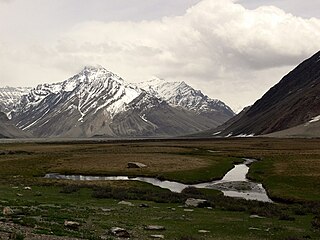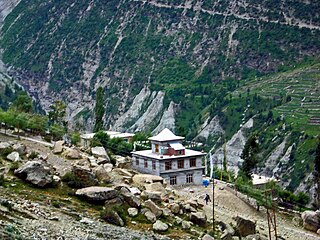
Zanskar, Zahar (locally) or Zangskar, is a tehsil of Kargil district, in the Indian union territory of Ladakh. The administrative centre is Padum. Zanskar, together with the neighboring region of Ladakh, was briefly a part of the kingdom of Guge in Western Tibet. Zanskar lies 250 km south of Kargil town on NH301.

Padum is the main town and the administrative centre of the Zanskar tehsil in Kargil district, Ladakh, India. Name after the Buddhist guru Padmasambhava, it was historically one of the two main capitals of the Zanskar Kingdom, the other being Zangla. It is 235 km (146 mi) via the link road from Kargil city. The new Nimmu–Padum–Darcha road connects Padum directly to Leh in the east and to Darcha in Himachal Pradesh.

Alchi is a village in the Leh district of Ladakh, India. It is located in the Likir tehsil, on the banks of the Indus River 70 km downstream from the capital Leh. Unlike the other gompas in Ladakh, Alchi is situated on lowland, not on a hilltop.

Ladakh has a long history with evidence of human settlement from as back as 9000 b.c. It has been a crossroad of high Asia for thousands of years and has seen many cultures, empires and technologies born in its neighbours. As a result of these developments Ladakh has imported many traditions and culture from its neighbours and combining them all gave rise to a unique tradition and culture of its own.

Rangdum is a village located in the Suru Valley in the union territory of Ladakh in Northern India. On one side are the colourful hills while on the other side are rocky mountains and glaciers, notably Drang-drung.

Pensi-la is a mountain pass in the Ladakh union territory of India, which is known as the Gateway to Zanskar. Pensi La is 4,400 metres (14,400 ft) above sea level and connects the Suru Valley region to the Zanskar Valley region. The summit at this end of the Suru Valley, the only peak which can be seen, is 7,012 metres (23,005 ft) high, while the mountain to the north is 6,873 metres (22,549 ft). The pass is about 25 km from Rangdum Monastery.

Tingmosgang is a fortress in Temisgam village, on the bank of the Indus River in Ladakh, in northwestern India. It is 92 km west of Leh, near Khalatse, and north of the present main road. The town has a palace and the monastery over a hillock.

Lamayuru or Yuru Monastery is a Tibetan Buddhist monastery in Lamayouro, Leh district, Ladakh, India. It is situated on the Srinagar-Leh highway 15 kilometres (9.3 mi) east of the Fotu La at a height of 3,510 metres (11,520 ft).

Khalatse, often written as Khaltse or Khalsi, is the headquarters of the eponymous subdivision, block and tehsil in the Leh district of Ladakh, India. It is located 95 km from Leh city on the old main road to Kargil, where it crosses the Indus over an iron bridge. Much of its importance is because it is the place where the road from Kashmir debouches into the Indus Valley.

Karsha Monastery or Karsha Gompa is a Buddhist monastery in the Padum Valley of the Zanskar region of the union territory of Ladakh in northern India. The Doda River flows past the monastery from its source at the Drang Drung Glacier of the Pensi La. It was founded by the translator Phagspa Shesrab. The monastery, also known by the name Karsha Chamspaling, was founded by Phagspa Shesrab, under the Gelugpa Order or Yellow Hats.

Lingshed Monastery or Lingshed Gompa is a Gelugpa Buddhist monastery in Ladakh, India. It is located near Lingshet village in the Leh district. It was founded in the 1440s by Changsems Sherabs Zangpo, disciple of Je Tsongkhapa, on a monastic site previously founded by the Translator Rinchen Zangpo. The monastery has belonged to the religious estate of Ngari Rinpoche since 1779. The Jangchub Tensung Dorje Center was founded in Lingshed by Kyabje Dagom Rinpoche in 1994.

Gandhola Monastery is about 18 kilometres (11 mi) before Keylong in Lahaul and Spiti district, Himachal Pradesh, India on the road from Manali, Himachal Pradesh. It is located on a hill above Tupchiling Village at the sacred junction of the Chandra and Bhaga rivers, which together form the Chenab River. The village is at 3,160 m (10,370 ft) and is famous for its 7-storey tower fort.

Rangdum Monastery is a Tibetan Buddhist monastery belonging to the Gelugpa sect, situated on top of a small but steep sugarloaf hill at an altitude of 4,031 m (13,225 ft) at the head of the Suru Valley, in Ladakh. It is next to the tiny village of Julidok, and about 25 km from the 4,400 m (14,436 ft) Pensi La (pass), which leads into Zanskar. The monastery was electrified using solar energy in June 2017 by Global Himalayan Expedition (GHE)

Likir Monastery or Likir Gompa (Klud-kyil) is a Buddhist monastery in Ladakh, Northern India. It is located at 3700m elevation, approximately 52 kilometres (32 mi) west of Leh. It is picturesquely situated on a little hill in the valley, in Likir village near the Indus River about 9.5 kilometres (5.9 mi) north of the Srinigar to Leh highway. It belongs to the Gelugpa sect of Tibetan Buddhism and was established in 1065 by Lama Duwang Chosje, at the command of the fifth king of Ladakh, Lhachen Gyalpo (Lha-chen-rgyal-po).

Matho Monastery, or Matho Gonpa or Mangtro Monastery or Mangtro Gonpa, from the Tibetan "mang" that means "many" and "tro" that means "happiness", is a Tibetan Buddhist monastery located 26 kilometres southeast of Leh in Ladakh, northern India, on the banks of the Indus River. The village of Matho is located at the mouth of a deep gorge running out of the Zanskar Range and across the Indus. It is directly opposite Thikse Monastery.

Sankar Monastery, or Sankar Gompa is a Buddhist monastery within an easy half-hour walk from Leh in Ladakh, northern India. It is a daughter-establishment of Spituk Monastery and the residence of the Abbot of Spituk, the Venerable Kushok Bakula, who is the senior incarnate lama of Ladakh due to his ancient lineage and personal authority.

Mulbekh Monastery or Mulbekh Gompa consist of two gompas, one Drukpa and one Gelugpa Buddhist monastery in Kargil, Ladakh, northern India. Names of the monasteries are Serdung Gompa and Rgaldan-se Gompa of Drukpa and Gelugpa sect respectively. Rgaldan-se Gompa was established by Tungba Lzawa also known as Agu Tungba. Recently the Rgaldan-se Gompa was reconstructed in 2016. It also consist a Lhakhang known as Nyima Lhakhang, it is the oldest section of the Mulbekh Monastery. It is believed to be built around 800 year ago by the students of great Tibetan scholar Lotsawa Rinchen Zangpo, it is clear with the style of painting.
Sani Monastery, Sa-ni-[tshog], is located next to the village of Sani where the Stod Valley broadens into the central plain of Zanskar in Ladakh, northern India. It is about 6 km to the northwest of the regional centre of Padum, a gentle two-hour walk. Like Dzongkhul Monastery, it belongs to the Drukpa Kargyu school of Tibetan Buddhism, and is the only one of this order in Zanskar which has nuns. It is thought to be the oldest religious site in the whole region of Ladakh and Zanskar.

Stongdey Monastery, often written Stongde, Stongday, Tonday or Thonde, is a flourishing Buddhist monastery in Zanskar, Ladakh, northern India, approximately 18 km north of Padum, on the road to Zangla.

Hanle Monastery is a 17th-century gompa of the Drukpa Lineage of the Kagyu school of Tibetan Buddhism located in the Hanle Valley, Leh district, Ladakh, India on an old branch of the ancient Ladakh-Tibet trade route. The valley is home to about a thousand people, with about 300 people living in Hanle village. The monastery is home to about ten monks while another 33 or so come regularly for prayers. It is only 19 kilometres (12 mi) from the disputed frontier between India and Chinese-controlled Tibet.
978-0674012875.





















